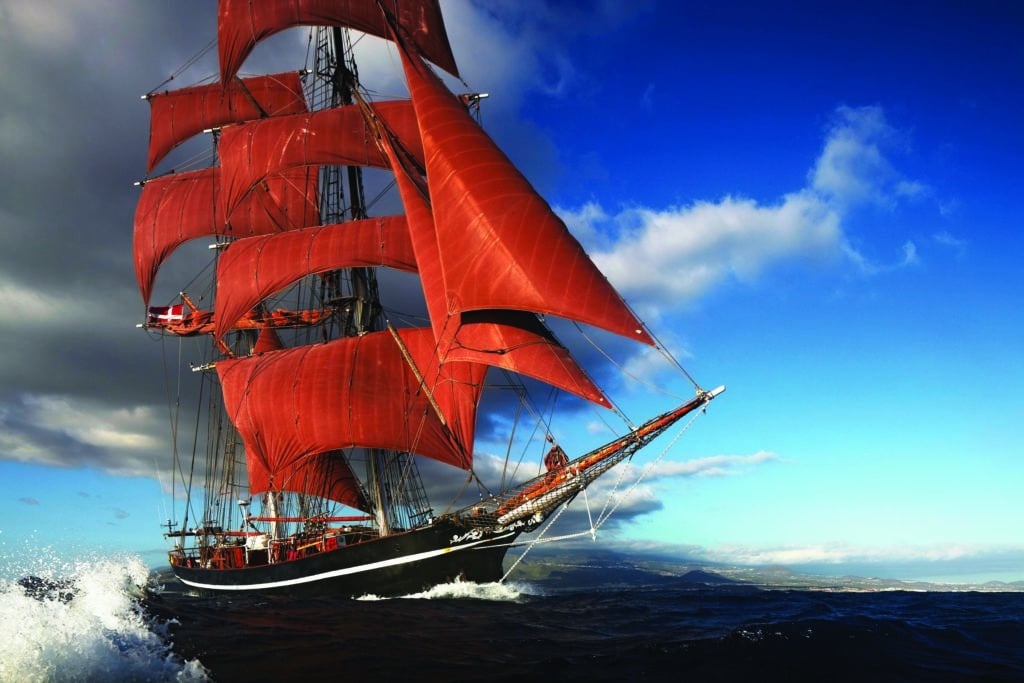
As my husband, Charter Weeks, and I fasten our seat belts in preparation for landing, our pilot announces that we are approximately 125 miles from Boston’s Logan Airport and will be at the gate in about 25 minutes. That 125 miles, it strikes me, represents the distance we traversed in any 24-hour period as we negotiated the Atlantic on an eight-day voyage from Tortola, in the British Virgin Islands, to Bermuda on the brigantine Eye of the Wind.
We are returning from an ocean adventure that offered us an extraordinary gift, one I can’t imagine we could have experienced any other way, particularly in this new century with its insistent demands.
This trip gave us the gift of time. Days and nights were carved into arbitrary segments according to watches. For long, gentle hours, time passed as slowly as drifting clouds. Then, almost without warning, if the clouds massed and darkened and scudded, time accelerated, and we had to be quick to respond to the immediate demands of wind and sails. Those patterns repeated. With reference only to wind, water and sky, notions of time — time away, time on our hands, time past and timelessness — took on new meaning. We were suspended in the elements, cut off from all the cues we had come to rely on, dependent on and tuned in to elemental forces. And happy.
Charter and I had flown from Boston to St. Thomas, in the U.S. Virgin Islands, and taken the ferry to Road Town, Tortola. There we met Nathan, Charter’s best friend from high school, and his wife, Linda, at a small restaurant near the ferry dock. Over dinner we talked about what had prompted this trip. Nate’s great-great-uncle Benjamin Briggs had captained the brigantine Mary Celeste, which on Dec. 4, 1872, was found underway, with tattered sails, hundreds of miles off the Azores. Missing were Briggs, his wife, his daughter, and a crew of seven. The ship, intact but for a missing logbook, sextant and lifeboat, showed no signs of damage or struggle. The contents of the hold were untouched; the cabins and galley and deck shipshape. The riddle of the mystery ship has never been solved, and Nate has had a lifelong fascination with the details of his relatives’ fate.
Enamored of such sailing vessels, he had been following Eye of the Wind‘s schedule on its website, waiting for an opportune time to book passage on the ship, as it would be as close as he would come to experiencing his ancestors’ days aboard Mary Celeste. He discovered that Eye of the Wind, which had spent the winter in the Caribbean offering weeklong excursions around the islands, would be sailing back to its home port in Jersey, off the coast of France, via the Azores, with a stop in Bermuda, and that it was taking paying passengers. He and Linda signed up and invited us to do the same.
So here we are in Tortola, under a waxing moon with the other guests, about to climb into the dinghy that will deliver us in shifts to Eye of the Wind. Once aboard, we stow our gear in our small cabins and meet in the galley for introductions. There are 11 passengers — 10 adults and an 11-year-old boy — and 10 crewmembers, hailing from Switzerland, Germany, Denmark, Sweden and Spain. We will spend the next 10 days together. Eating and sleeping. Working and reading. Conversing and staring silently out at the endless sea and night sky. We raise glasses of champagne in a toast (after we clean up the remains of several shattered flutes tossed to the deck by a sudden swell). Then our chef, Marina, and her brother, Sergio, serve us dinner. We sleep in a rolling anchorage. The wind in the rigging resonates in the steel hull like a bass violin.
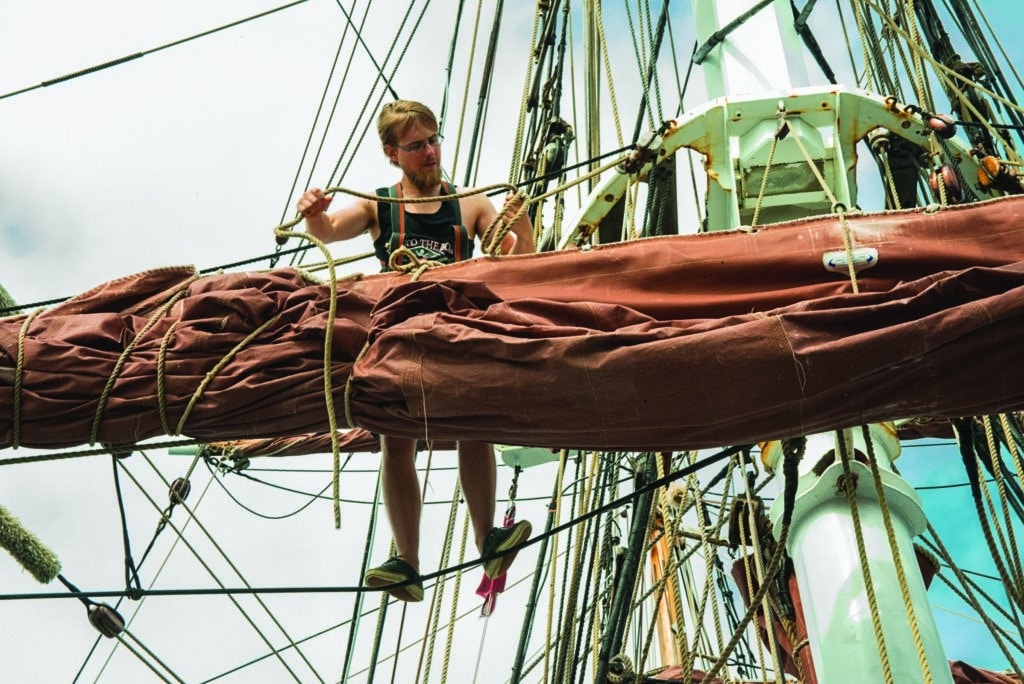
Sunday morning, Capt. Cornel gathers us on deck. We’re anchored off Jost Van Dyke, after having refueled and topped off the water tanks. We’ll all have a last day and night to swim, snorkel, drop by a beach pub, eat without concern for the placement of our plates, shower without bracing ourselves against the bulkheads, and sleep without rolling into one another. But first, the orientation.
“This is your captain speaking,” he announces with a smile. It’s 1000. We will become used to meeting at this time every morning for class. Today Cornel instructs us, with a mixture of humor and seriousness, in the rudiments of living on a tall ship. The importance of conserving water. How to move about. Where to put our hands and feet. How and when to assist the crew — or stay out of their way.
He reviews the various parts of the boat, gives us a primer on its myriad sails and lines, and talks about our course and projected progress. Some of us are seasoned sailors who have made ocean passages. Some have sailed a bit, but not offshore. Some have never set foot on a sailing ship until this day. We are strangers united, at least for the next 10 days, in a common endeavor, and we’ll all take our chosen parts.
Cornel tells us that once we’re underway, there will be four-hour watches each manned by three or four crew plus willing passengers. He invites any interested guests to volunteer. Several of us do.
When the first mate, Britta, begins her safety lecture, I am prepared to half-listen as if to a bored flight attendant. What follows, however, is a catalog of what incidents could occur and what to do should they befall the ship and its passengers. The safety lecture begins with Britta pointing out the woven “man-catchers” stretched amidships between stays, port and starboard. She cautions us to always keep a hand on rail or rope. She asks that we inform crewmembers on watch if we come on deck at night, and that we tell them when we go below.
And then she gets to the meat of it: Injuries and illness will receive the best first aid the crew can offer, but there are no doctors on board. A man overboard will occasion a very specific series of reactions and responses (but they are unlikely to be successful at night). Fire is disastrous on a boat, and will be met with everything from ordinary extinguishers to the fire-trained crew combating the blaze wearing fireproof gear and gas masks. Not only are we shown the location of the life vests, but we are asked to don them for practice. Britta describes how to climb into a survival suit, and a fellow passenger demonstrates. She points out the life rafts hanging from davits and details how to board them — and failing that, how to hook onto one another as we bob in the ocean waiting for rescue. It is a sobering exercise.
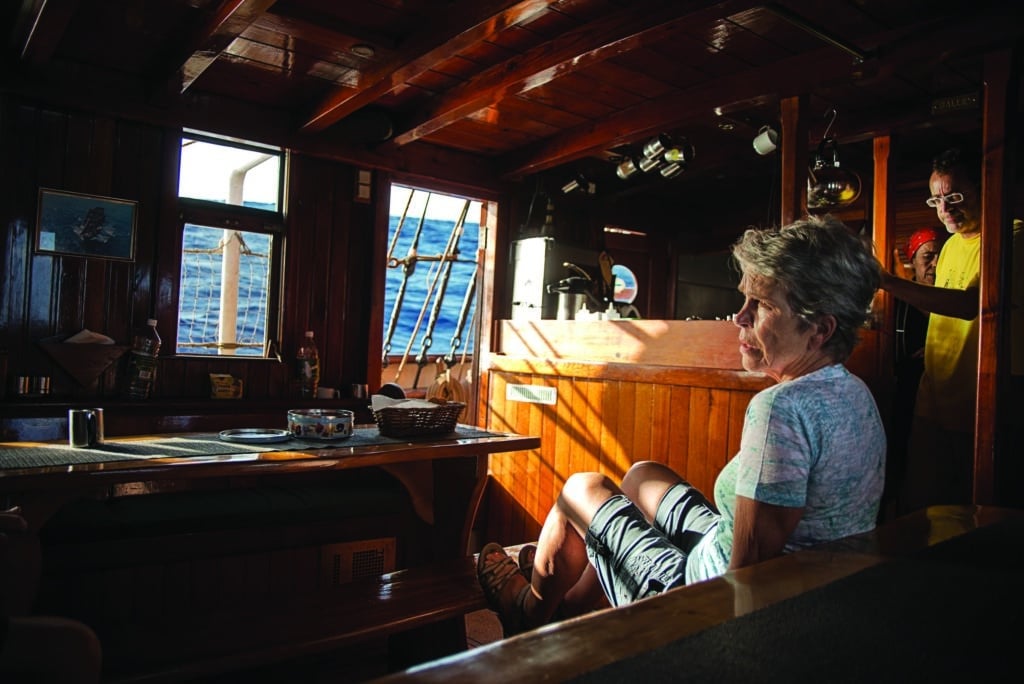
The huge anchor is raised to signal bells and clanking of chain. Magnificent frigate birds wheel overhead. The wind is picking up, and the crew is busy with lines. Jibs and staysails snap out. Topsails unfurl. We are underway. In a few hours the islands will be pale smudges on the horizon. Soon land will disappear, and with it our connections to cellphones and laptops. We’ve begun our 830-mile voyage to Bermuda.
Originally christened Friedrich, the steel-hull ship was built as a trading schooner in 1911. In 1923, renamed Merry, she transported goods in the Baltic and North seas and was used as a fishing vessel off Iceland in the summers. By 1969, stripped of her masts and sailing under power, she suffered a devastating fire and was about to be scrapped when a group of Australians, looking for a boat to restore as a square rigger, bought Merry and went to work clearing the fire debris, scraping and painting the hull, installing a new steering system, overhauling the engine, and tackling the interior.
As I wander from galley to saloon to our cabin, I note the provenance of the furnishings as detailed in various books and websites: a teak floor from a dance hall; church pews for galley seating; deep brown paneling from a bank; and scores of items — doors, windows, all manner of fittings — gleaned from old ships and marine suppliers. The boat’s ballast was initially comprised of used paving stones, concrete railway sleepers and gravel. The masts, two 20-inch-diameter steel oil-well casings, were wrestled into place by sheer manpower.
Granted, where there would have been barrels and crates filled with trade goods, there are now six en suite guest cabins, air-conditioned several hours a day and fitted out with comfortable bunks, a closet, a bookshelf and a small bench. Where there would have been narrow berths for the crew, there are now tidy bunks and a head. The saloon would not have been a cozy retreat offering a library of paperbacks and DVDs. And while Capt. Briggs and his wife and daughter enjoyed the comfort of a wood stove and the pastimes of sewing and singing to the accompaniment of a melodeon aboard Mary Celeste, on Eye of the Wind, Cornel and Britta share the small living space aft with chart tables and navigational instruments. Still, we are settling into the past.
The daily briefing begins with Cornel spreading the chart atop the cabin house to show us how far we’ve come in 24 hours — usually about 125 miles at just under 6 knots. He follows that with a short discourse on one or another aspect of the workings of the ship, and the myriad choices and decisions he makes as he chooses course, decides which sails to deploy, responds to a sudden squall, or resorts to the engine to keep us on schedule for Bermuda. Cornel is clearly in charge of every aspect of this voyage, in easy command of the ship, its guests and crew.
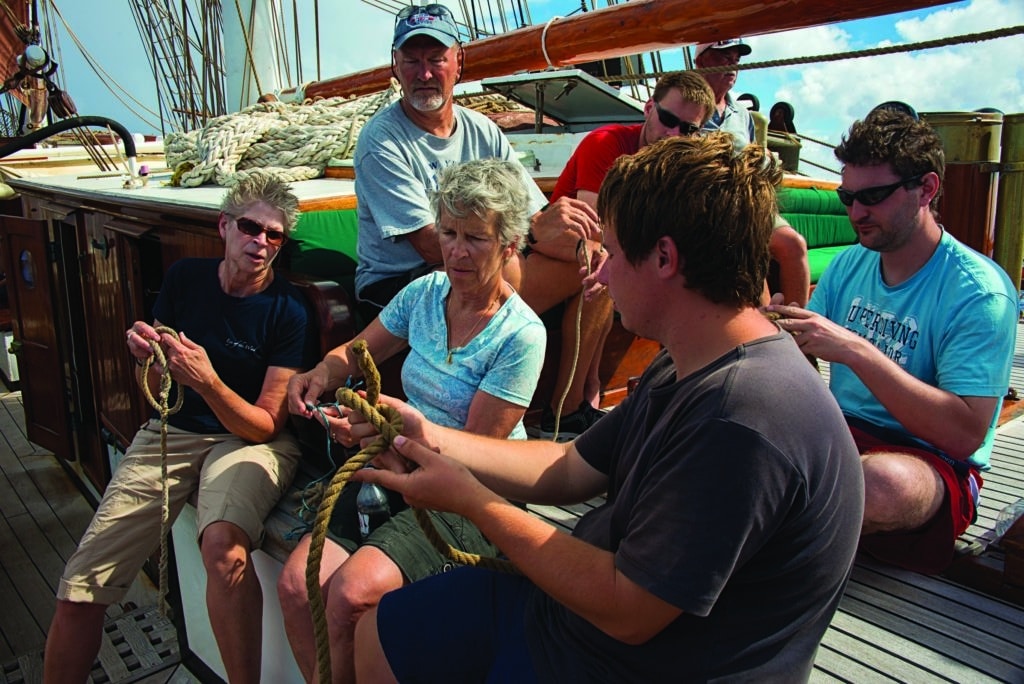
As the crew go about their daily routines — two-hour repair and maintenance shifts to keep the “Old Lady” shipshape — I am struck by their willingness to include us. The more we volunteer to participate, the more we’re taught, until they can count on us to help. The halyards, sheets and downhauls, neatly hung on wooden belaying pins lined along the rails, must be re-coiled every time we set a sail or adjust a yard. We take turns at the helm and are allowed to make mistakes as we work to get the hang of steering a course. Some of us even strap on harnesses and safety clips to follow crewmember Astrid up the ratlines, high into the rigging, as she and Christoph furl the topgallant or inspect lines.
The only day exempt from the usual obligations is Sunday, designated for what used to be called “Make and Mend,” when sailors found respite from chores and turned their attention to personal projects. On our Sunday at sea, Astrid, for one, finishes work on the ditty bag that she has expertly sewn from canvas and braided line.
One morning, Rasmus hands out short lengths of rope to the guests so we can practice the knots he patiently demonstrates: bowline, clove hitch, sheepshank (for some reason, I particularly like this knot that makes a long line shorter), rolling hitch. We are occupied for most of the rest of the morning tying and untying. Ole gives our friend Nate a private tutorial on how to make a Turk’s head.
On another morning, Cornel invites Nate to explain the principles of celestial navigation. In the spirit of the voyage of Mary Celeste, Nate has brought his own sextant aboard. He takes readings at noon and sunset every day. Though already trained in celestial navigation, Rasmus and Christoph devote precious off-hours with Nate to honing their skills for calculating our position by this means. Others of us struggle to grasp even the rudiments of this arcane and beautiful science, which weaves a knowledge of the stars and planets, longitude and latitude, angles and magnetic forces, winds and currents into an elegant map of a vast ocean, upon which a very small vessel is making its way from shore to shore.
Chief engineer Andreas explains the workings of the engine, generator and reverse-osmosis watermaker, which he and Lars, the machinist, are constantly tinkering with. Today they are completely remaking a recalcitrant pump. Even with some 21st-century technology, the spirit of maintenance and improvisation is decidedly 19th-century — and very necessary.
We guests must improvise as well. We pool what resources are on board with what we have brought to effect a cure for our young passenger’s relentless bout of seasickness. We create relief by way of pills, arnica salve and ice packs for the back sprain I sustain in a spectacular fall on deck the one time I go barefoot. We concoct remedies of broth and ginger tea for several mild stomach upsets.
From the galley come strains of the music Marina has chosen to enliven her lunch prep. Sergio peels potatoes. Ole dries the breakfast dishes before he goes below to sleep. One of us guests mops tables and sweeps up crumbs while a cribbage game is underway in the corner. Our meals are both simple and imaginative. Breakfast is a spread of cold meats and cheeses, fruit, homemade breads, jams (including an Andalusian specialty called membrillo, which Sergio has contributed), juices and cold cereals. Lunch might be a hearty hot dish such as leftover pork tortillas or a grain salad rich with chopped vegetables. The bell rings for tea in the late afternoon, when we snack on cookies and some days sorbet. And from her tiny galley, Marina prepares ample dinners of roasted meat, baked fish, creamy risotto and grilled sausage. She dishes out and we pass carefully to each other as the ship rolls and pitches. We eat together — captain, guests and whoever of the crew isn’t sleeping — and share stories and jokes, gradually morphing, as the days go by, into a cheerful, bantering family.
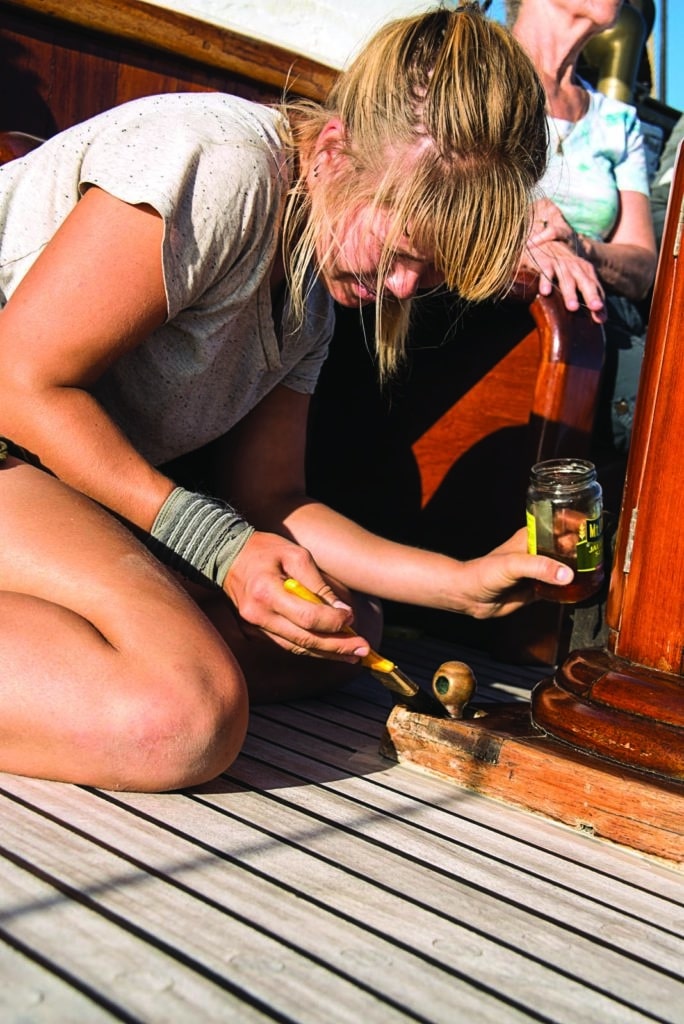
Twice we are gifted with food from the ocean. The first catch, off a filament line trailed off the stern and baited with a flying fish, is a 15-pound dorado, its scales glistening blue and yellow and silver. The second, a white marlin weighing more than 28 pounds, is dispatched — at Nate’s suggestion that it is the quickest, most humane method — by pouring a measure of strong spirits down its gullet and into its gills. Sure enough, the fish expires almost instantly and without struggle. A few of us pool gutting and boning and filleting skills, and Marina creates memorable dishes from the catch, sauced and spiced to perfection, with ample fish left over to freeze.
Surprisingly, though, aside from our two fish, the occasional red-footed booby diving into squadrons of flying fish, and some Portuguese man-of-war sailing on the crests of waves, we see very little wildlife.
Our days and nights assume a pattern around watches, meals, and long stretches of time spent simply being in this place, looking and listening. The air is incredibly pure. (Oddly, there is no sea smell this far from land.) The light is extraordinary. There is a deep silence, if silence can be defined by the slosh of water through the scuppers when the boat plows into a swell; by wind in the shrouds and breezes that brush past us on the rail; by the creaks of lines, the luff of jibs, the slap of halyards against masts. It’s a silence that’s devoid of beeps or rings or buzzes, but allows shouts from aloft and laughter below.
Long strands of seaweed from the Sargasso Sea float on water that changes color and aspect almost hourly. Small squalls come and go. The sky is empty and monochrome on a gray morning, then crowded with towering clouds all through a bright blue afternoon. We are propelled by a fine wind for days, then slowed to a sluggish pace as we enter the horse latitudes and must resort to the engine.
By the time we have been at sea for almost a week, untethered from our cords and plugs, we have lost all reference to whatever might be occurring on land. And we have stopped caring. Even seeing each new position on the chart, I find distance and land strangely abstract concepts. It’s difficult to imagine anything other than the impossibly deep blue sea that stretches beneath an endless paler-blue sky. Waves form, crest and disappear under the hull; night extinguishes one orange sunset after another, replacing each with a black canvas presided over by an enormous moon, marching from full to wane as we are treated to an increasing vista of stars. We leave a phosphorescent swath in our wake.
On Sunday night, on Rasmus’ watch, the glow that is Bermuda appears as a pale-yellow brushstroke on the horizon. By noon on Monday, with a crisply uniformed pilot on board and Cornel confident at the helm, we pass through Town Cut and tie up at Ordnance Island in St. George. This pastel and palmy island will be the point of entry back into our busy, connected lives. As Cornel and his crew prepare to continue on to the Azores with a new complement of guests, we reacquaint ourselves with the familiar definitions and stricter requirements of land time. It is a melancholy moment.
Marie Harris is a writer, editor and former New Hampshire poet laureate. Her husband, Charter Weeks, is a documentary photographer and filmmaker.








